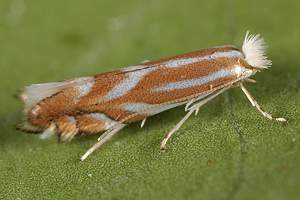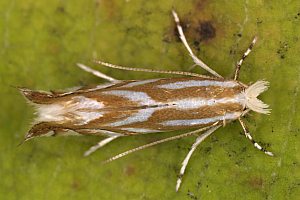1. Lebendfotos
1.1. Falter
1.2. Puppe
2. Diagnose
Lithocolletinae, alph. geordnet nach den wissenschaftlichen Namen ihrer Raupennahrungspflanzen
2.1. Männchen
2.2. Genitalien
2.2.1. Männchen
2.2.2. Weibchen
2.3. Erstbeschreibung
3. Biologie
3.1. Habitat
3.2. Nahrung der Raupe
- [Fagaceae:] Quercus robur (Stiel-Eiche)
- [Fagaceae:] Quercus petraea (Trauben-Eiche)
- [Fagaceae:] Quercus pubescens (Flaum-Eiche)
- [Fagaceae:] Quercus cerris (Zerr-Eiche)
- [Fagaceae:] Quercus pyrenaica (Pyrenäen-Eiche)
- [Fagaceae:] Quercus ilex (Stein-Eiche)
Die Art miniert unterseitig an Stiel-Eiche (Quercus robur), Trauben-Eiche (Q. petraea), Pyrenäen-Eiche (Q. pyrenaica) und Stein-Eiche (Q. ilex) [Bradley, Jacobs & Tremewan (1970)]. Gracillariidae.net ergänzt noch die Flaum-Eiche und die Zerr-Eiche, erwähnt aber die immergrüne Stein-Eiche nicht - sie scheint zumindest nur geringe Bedeutung zu haben.
(Autor: Erwin Rennwald)
4. Weitere Informationen
4.1. Andere Kombinationen
- Lithocolletis distentella Zeller, 1846 [Originalkombination]
4.2. Faunistik
Laštůvka & Laštůvka (2014: 635-636) melden die Art erstmals für Spanien und erläutern: "ES: Barcelona, San Sadurní de Osormort, mines on Quercus pubescens, 26-VI-2014, 1 ♀ ex pupa, VI-2014, Santa María de Oló, mines on Q. pubescens, 25-VI-2014, 1 ♂, 2 ♀♀ ex pupa, VI-2014; Gerona, Espinelves, 2 ♀♀ and mines on Q. pubescens, 7-VI-2014, 1 ♀ ex pupa, VII-2014; Huesca, Espés-Alins, 1 ♀, 8-VI-2014; León, Pardesivil, 1 ♂, 1 ♀, 20-VI-2014. PT: Beira Alta, Pinzio, mines on Quercus pyrenaica, 17-VI-2011, 2 ♂♂ ex larva, VI-2011. Species distributed in central and southern parts of Europe and western Asia, its larva prefers Quercus pubescens, but also other Quercus species as host plants are given (DE PRINS & DE PRINS, 2005, 2014). In the Iberian Peninsula known from some localities in Portugal (MENDES, 1905, DE PRINS & DE PRINS, 2005, 2014, M. Corley, pers. comm.). New species for Spain (Figs. 22, 23)."
Šumpich (2013: 17) meldet aus Kroatien:"Biograd, 5.–12.vii.2003, 3 ♂ (det. A. Laštůvka). Locally distributed in many European countries, absent in the north. The occurrence in the Balkans is mentioned only by De Prins & De Prins (2005), from Croatia, but without faunistic details."
Rákosy & Goia (2021: 185) melden Bedenken gegen die Angabe aus Rumänien an: "Species, mentioned in the Romanian Microlepidoptera Checklist (Popescu-Gorj 1984/5). We do not know the source of this record."
4.3. Literatur
- Laštůvka, A. & Z. Laštůvka (2014): New records of mining moths from the Iberian Peninsula from 2014 (Insecta: Lepidoptera). — SHILAP Revista de Lepidopterología, 42 (168): 633-647. [PDF auf redalyc.org]
- Rákosy, L. & M. Goia (2021): Lepidopterele din România: lista sistematică și distribuție. The Lepidoptera of Romania: a Distributional Checklist. — 369 p.; Cluj-Napoca (Presa Universitară Clujeană).
- [SCHÜTZE (1931): 77]
- Šumpich, J. (2013): Faunistic records of some Microlepidoptera from Croatia. — Entomologia Croatica, 17 (1–4): 13–33. [PDF auf hrcak.srce.hr] bzw. [PDF auf entomologicalservice.com]
- Erstbeschreibung: Zeller, P. C. (1846): Die Arten der Blattminirergattung Lithocolletis. — Linnaea Entomologica 1: 166-261 + tab. 1.



![Vorkommen in Österreich [Huemer (2013: NR 0700)]](/res/img/flag/at.png)
![Vorkommen in Polen [Buszko J. & J. Nowacki [eds] (2017): A Distributional Checklist of the Lepidoptera of Poland]](/res/img/flag/pl.gif)
![Vorkommen in Tschechien [Laštůvka, Z. & J. Liška (2011): Komentovaný seznam motýlů České republiky]](/res/img/flag/cz.gif)

![Vorkommen in Ungarn [Pastorális et. al. (2018): A Magyarországon előforduló molylepke-fajok névjegyzéke]](/res/img/flag/hu.gif)
![Vorkommen in Großbritannien [Agassiz, Beavan & Heckford (2013): Checklist of the Lepidoptera of the British Isles]](/res/img/flag/gb.gif)
![Ausgestorben oder verschollen in Belgien [De Prins(2016): Catalogus van de Belgische Lepidoptera]](/res/img/flag/be.gif)
![Vorkommen in Frankreich (europäisches Territorium ohne Korsika) [Vandromme et al. (2020): Liste systématique et taxinomique des Lépidoptères de France]](/res/img/flag/fr.gif)
![Vorkommen in Spanien (Festland) [Vives Moreno A. (2014)]](/res/img/flag/es.gif)
![Vorkommen in Portugal (Festland) [Corley (2015): Lepidoptera of Continental Portugal]](/res/img/flag/pt.gif)
![Vorkommen in Italien (Festland und kleine festlandsnahe Inseln) [Gaedike et al. (1995): Checklist delle Specie della Fauna Italiana 81]](/res/img/flag/it.gif)
![Vorkommen in Slowenien [Lesar & Govedič (2010): Check list of Slovenian Microlepidoptera]](/res/img/flag/si.gif)

![Vorkommen in Serbien [Jakšić (2016): Tentative Checklist of Serbian microlepidoptera]](/res/img/flag/rs.gif)
![Fragliches Vorkommen in Rumänien [Rákosy L. & M. Goia (2021): Lepidopterle din România: lista sistematică şi distribuţie]](/res/img/flag/ro.gif)




























